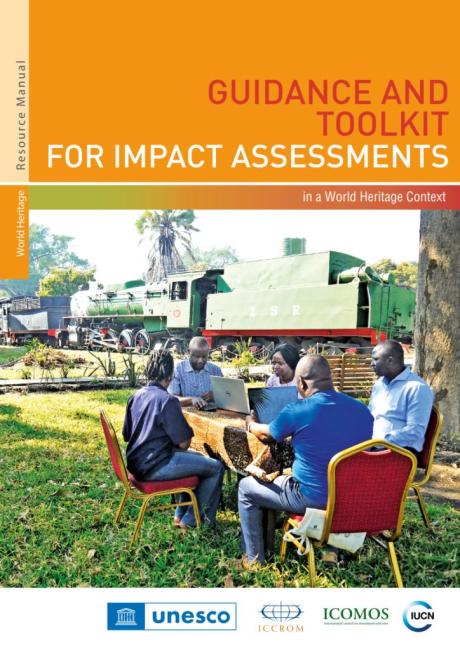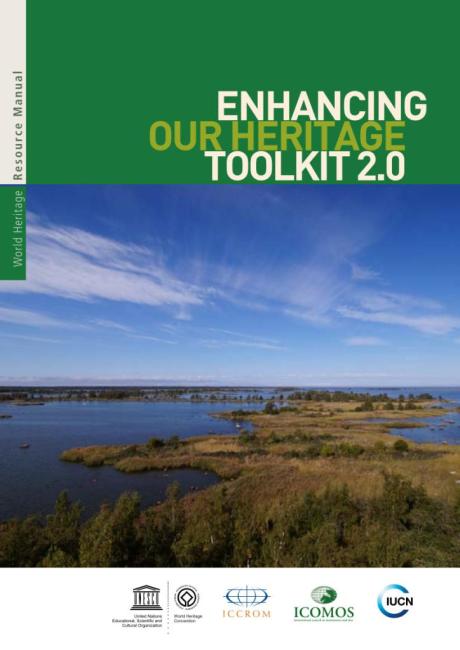Management systems for heritage places
- A management system for World Heritage should provide effective protection over time and ensure that all its heritage values, including its OUV are maintained.
- A management system aims to ensure that the conservation of the
World Heritage property
A cultural, natural or mixed heritage place inscribed on the World Heritage List and therefore considered to be of OUV for humanity. The responsibility for nominating a property to the World Heritage List falls upon the State(s) Party(ies) where it is located. The World Heritage Committee decides whether a property should be inscribed on the World Heritage List, taking into account the technical recommendations of the Advisory Bodies following rigorous evaluation processes.
When used as a general term, World Heritage refers to all the natural, cultural and mixed properties inscribed on the World Heritage List. generates benefits for its associated communities and that it contributes to wider societal goals when possible, such as sustainable development. - A management system is best understood as the combination of institutional structures, instruments and processes that together ensure the effective protection of the
World Heritage property
A cultural, natural or mixed heritage place inscribed on the World Heritage List and therefore considered to be of OUV for humanity. The responsibility for nominating a property to the World Heritage List falls upon the State(s) Party(ies) where it is located. The World Heritage Committee decides whether a property should be inscribed on the World Heritage List, taking into account the technical recommendations of the Advisory Bodies following rigorous evaluation processes.
When used as a general term, World Heritage refers to all the natural, cultural and mixed properties inscribed on the World Heritage List. . - Management systems can vary considerably according to the specific type of heritage place (e.g. a building, an urban area, a forest, a seascape) but also the different cultural perspectives, historical dimensions, political factors, institutional capacities and available resources. For World Heritage, the Operational Guidelines recognize this diversity of existing management systems and outline common aspects of an effective management system.
- Analysing a heritage management system according to its different elements helps to see where strengths and weaknesses lie and provides a good departure point to overcome any shortcomings.
World Heritage properties must demonstrate an appropriate and effective protection and management system in order to be inscribed on the World Heritage List. The Operational Guidelines state that the purpose of a management system is to ensure the effective protection of the nominated property for present and future generations. Such a system must first and foremost ensure that all its heritage values, including its OUV, are maintained (see 3.1). A management system will also aim to ensure that the conservation of the
World Heritage property
A cultural, natural or mixed heritage place inscribed on the World Heritage List and therefore considered to be of OUV for humanity. The responsibility for nominating a property to the World Heritage List falls upon the State(s) Party(ies) where it is located. The World Heritage Committee decides whether a property should be inscribed on the World Heritage List, taking into account the technical recommendations of the Advisory Bodies following rigorous evaluation processes.
When used as a general term, World Heritage refers to all the natural, cultural and mixed properties inscribed on the World Heritage List.
generates benefits for its associated communities, and that it contributes to their well-being as well as wider societal goals when possible, such as sustainable development. Management systems that explicitly integrate such aims from the outset and adopt participatory approaches are more likely to succeed through wider acceptance and support.
Each place has a unique combination of heritage values and attributes with specific conservation needs, and different ways of being able to contribute to societal needs and aspirations. Understanding this and establishing consensus around the overarching purpose of its heritage management system, is the basis for defining management objectives for the heritage place. These objectives set the broad direction (or guiding principles) for the whole management system, including what must be done to maintain the OUV of the
World Heritage property
A cultural, natural or mixed heritage place inscribed on the World Heritage List and therefore considered to be of OUV for humanity. The responsibility for nominating a property to the World Heritage List falls upon the State(s) Party(ies) where it is located. The World Heritage Committee decides whether a property should be inscribed on the World Heritage List, taking into account the technical recommendations of the Advisory Bodies following rigorous evaluation processes.
When used as a general term, World Heritage refers to all the natural, cultural and mixed properties inscribed on the World Heritage List.
and its overall heritage significance, what management measures are necessary to conserve the attributes, how the property can contribute to sustainable development, and what benefits it aims to generate. Finally, what is undertaken in pursuit of those objectives and the means and actions applied to achieve them, becomes the focus of everyday management.
Examples of management objectives could include: conserving in situ the fossils in a fossil deposit; maintaining the townscape of a human settlement; fostering the traditional occupations and livelihoods of communities and Indigenous Peoples associated with a cultural landscape; preserving a particular traditional building technique through its continuous use and application; or limiting access to certain areas to ensure the viability of habitats critical to a specific endangered migratory species.
For World Heritage properties, it is paramount to ensure that management objectives primarily seek to maintain the values for which they have been inscribed on the World Heritage List: their OUV. Other complementary but sometimes secondary objectives may then be added. When it comes to broader contributions to society, most heritage places should also aim, for example, to:
- deliver sustainable benefits to Indigenous Peoples and other associated communities;
- encourage opportunities for people to engage in meaningful ways with their heritage;
- provide appropriate visitor experiences;
- facilitate research activities that complement management needs with consent of rights-holders;
- help to provide two-way learning opportunities; and
- develop public support for conservation.
As noted above, maintaining heritage values, including the OUV, should be the unambiguous priority. While management objectives should not be in conflict, there may be occasions where compromises need to be made to respond to the aspirations of different actors. An example might be finely balanced decisions around the management of water catchments to protect significant marshland ecosystems while sustaining traditional livelihoods, or the need for historic buildings to meet regulatory requirements for safety while maintaining their original materials, layout and design. So, setting unambiguous and agreed management objectives, with the full and effective participation of all relevant rights-holders and stakeholders, can help to alleviate potential tensions between conservation and development.
The Operational Guidelines do not provide a definition of management systems due to the variability across all properties and there is a general tendency to use ‘management systems’ and ‘management plans’ interchangeably. However, a management system is best understood as the combination of institutional structures, instruments and processes that together ensure the effective protection of the
World Heritage property
A cultural, natural or mixed heritage place inscribed on the World Heritage List and therefore considered to be of OUV for humanity. The responsibility for nominating a property to the World Heritage List falls upon the State(s) Party(ies) where it is located. The World Heritage Committee decides whether a property should be inscribed on the World Heritage List, taking into account the technical recommendations of the Advisory Bodies following rigorous evaluation processes.
When used as a general term, World Heritage refers to all the natural, cultural and mixed properties inscribed on the World Heritage List.
; whereas a management plan is an instrument that mainly indicates how the management system works, outlines what is to be achieved and what actions need to be implemented over a certain period of time.
Possible common elements of an effective management system provided in the Operational Guidelines are:
- a thorough shared understanding of the property, its universal, national and local values, and its socio-ecological context by all actors, including associated communities and Indigenous Peoples;
- a respect for diversity, equity, gender equality and human rights and the use of inclusive and participatory planning and consultation processes;
- a cycle of planning, implementation, monitoring, evaluation and feedback;
- an assessment of the vulnerabilities of the property to social, cultural, economic, environmental and other pressures and changes, including disasters and climate change, as well as the monitoring of the impacts of trends and proposed interventions;
- the development of mechanisms for the involvement and coordination of the various activities between different actors;
- the allocation of necessary resources;
- capacity-building;
- an accountable, transparent description of how the management system functions.
This list of elements is not exhaustive. In considering heritage management systems, it is important to recognize that they can have very different compositions. Most heritage management systems draw on efforts from diverse institutions, and from an array of legal, customary and regulatory instruments, which can be heritage and non-heritage specific operating at national, regional and/or local levels. In the case of World Heritage, the management system routinely includes a combination of administrative levels, since the ultimate responsibility for their protection lies with the State Party, while most management actions take place locally.
It should also be noted that at many heritage places, including World Heritage properties, elements of the management system will not always lie entirely within the heritage sector. Other sectors and their agencies, as well as civil society associations and private organizations, may have formal and informal powers over heritage and exert influence on management. For example, historic urban areas are often managed by municipal authorities, where heritage agendas are only one small part of their mandate. Similarly, many heritage places, including some World Heritage properties, include areas that are managed by Indigenous Peoples or by religious communities.
In some cases, the management system incorporates a mix of traditional, formal and informal instruments, institutional and customary structures, practices and processes. For instance, governmental oversight can overlap with living traditions and customary management practices to protect a farming landscape or a sacred mountain.
Some management systems draw strongly on decision-making and management processes at a national level that involve certain amounts of political will and intentions; this is typical of centralized management approaches. Others may operate mostly at a provincial or local level. Often the elements of these management systems are not exclusive to one particular heritage place but cover many in one country or single jurisdiction. For instance, a heritage unit at a municipality may be responsible for managing all the designated heritage places within its jurisdiction. In a few cases, the management entity might be equipped with elements specific to a heritage place and enjoy significant management autonomy.
Even heritage places managed by a single institution will be subject to a wide array of legislation, planning instruments and institutional frameworks. The reason for this is that those places cannot exist or be managed in isolation from their surroundings. Likewise, they are influenced by the social, cultural, political, economic and environmental context that influences the ability of that single institution to operate and fulfil its mandate. For instance, a historic monument, archaeological site or
national park may have a dedicated management authority. However, other actors may govern access to those heritage places or will have legal and customary rights to use the land surrounding them in ways that may affect their protection. In the case of natural World Heritage properties, urbanization, energy and transport infrastructure and extractive industry interests in buffer zones or the wider setting, are increasingly placing pressure on heritage places and important corridors for wildlife movement.
The elements of the management system are briefly summarized in the Statement of Outstanding Universal Value (SOUV) when a property is inscribed on the World Heritage List. To provide a structured way of thinking about a management system and how it functions, the following four parts of the manual explain the main elements needed to conserve a heritage place effectively:
- Heritage place: starting with its heritage values and attributes, which should form the basis for all management measures. Effective management also needs to be based on an understanding of the social, cultural, economic, and environmental context, particularly when that context explains the various factors that can affect the heritage place. The delineation of boundaries and buffer zone(s), as well as the understanding of the wider setting, play a critical role in responding to those factors. The wide range of services and benefits that a heritage place provides are also explored (see Part 3);
- Governance arrangements: understanding the range of actors associated with the heritage place and who is responsible and accountable for its management forms the basis for defining governance arrangements. To uphold their rights, exercise their powers and fulfil their responsibilities, actors use a variety of instruments, which are part of the legal, regulatory and customary framework. The coordination and decision-making processes that accompany governance arrangements also need to be assessed for quality against a set of ‘good governance’ principles (see Part 4);
- Management processes: planning, implementation and monitoring with allocation of adequate resources and interlinked to other management processes such as disaster risk management, impact assessment, urban heritage management and, tourism and visitor management, are important elements of the management system to achieve objectives linked to recreation, benefits generation, education or research (see Part 5);
- Results: regular assessments of a management system help evaluate whether it is delivering expected results in terms of maintaining the values of the heritage place and ensuring that management objectives are being achieved. Identifying changes that can lead to greater effectiveness and efficiency for continuous improvement is central to effective management. (see Part 6).
State of Conservation reports and Periodic Reporting continuously demonstrate the lack of effective management as one of the key negative factors threatening the protection of World Heritage All inherited assets which people value for reasons beyond mere utility. Heritage is a broad concept and includes shared legacies from the natural environment, the creations of humans and the creations and interactions between humans and nature. It encompasses built, terrestrial, freshwater and marine environments, landscapes and seascapes, biodiversity, geodiversity, collections, cultural practices, knowledge, living experiences, etc. . The IUCN World Heritage All inherited assets which people value for reasons beyond mere utility. Heritage is a broad concept and includes shared legacies from the natural environment, the creations of humans and the creations and interactions between humans and nature. It encompasses built, terrestrial, freshwater and marine environments, landscapes and seascapes, biodiversity, geodiversity, collections, cultural practices, knowledge, living experiences, etc. Outlook with assessments of all natural World Heritage All inherited assets which people value for reasons beyond mere utility. Heritage is a broad concept and includes shared legacies from the natural environment, the creations of humans and the creations and interactions between humans and nature. It encompasses built, terrestrial, freshwater and marine environments, landscapes and seascapes, biodiversity, geodiversity, collections, cultural practices, knowledge, living experiences, etc. properties have shown for example that only half are considered as being effectively managed. Analysing a heritage management system according to its different elements helps to see where strengths and weaknesses lie and provides a good departure point to overcome any shortcomings. Regular assessment of how well the management system is working will also help it adapt to changes in conservation practice, resources available and societal aspirations over time.
The assessment of management effectiveness has been a growing trend for many protected and conserved areas since the 1990s and an easy-to-use framework for evaluating management effectiveness was developed for natural World Heritage All inherited assets which people value for reasons beyond mere utility. Heritage is a broad concept and includes shared legacies from the natural environment, the creations of humans and the creations and interactions between humans and nature. It encompasses built, terrestrial, freshwater and marine environments, landscapes and seascapes, biodiversity, geodiversity, collections, cultural practices, knowledge, living experiences, etc. properties called the Enhancing our Heritage All inherited assets which people value for reasons beyond mere utility. Heritage is a broad concept and includes shared legacies from the natural environment, the creations of humans and the creations and interactions between humans and nature. It encompasses built, terrestrial, freshwater and marine environments, landscapes and seascapes, biodiversity, geodiversity, collections, cultural practices, knowledge, living experiences, etc. Toolkit (2008). This toolkit has now been expanded to work for all World Heritage All inherited assets which people value for reasons beyond mere utility. Heritage is a broad concept and includes shared legacies from the natural environment, the creations of humans and the creations and interactions between humans and nature. It encompasses built, terrestrial, freshwater and marine environments, landscapes and seascapes, biodiversity, geodiversity, collections, cultural practices, knowledge, living experiences, etc. properties as the Enhancing our Heritage All inherited assets which people value for reasons beyond mere utility. Heritage is a broad concept and includes shared legacies from the natural environment, the creations of humans and the creations and interactions between humans and nature. It encompasses built, terrestrial, freshwater and marine environments, landscapes and seascapes, biodiversity, geodiversity, collections, cultural practices, knowledge, living experiences, etc. Toolkit 2.0 (EOH 2.0, 2023). The updated Toolkit provides a set of twelve tools to analyse the critical elements of a management system and should be used as a companion to this manual.



